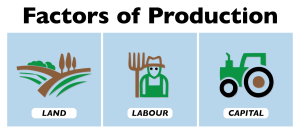1.3 Scarcity and the Fundamental Economic Questions
The choices we confront in society due to scarcity raise three issues. Every economy must answer the following BIG questions:
- What should be produced? Using the economy’s scarce resources to produce one thing requires giving up another. Producing better education, for example, may require cutting back on other services, such as health care. A decision to preserve a wilderness area requires giving up other uses of the land. Every society must decide what it will produce with its scarce resources.
- How should goods and services be produced? There are many choices to determine how goods and services should be produced. Should a firm employ a few skilled or a lot of unskilled workers? Should it produce in its own country, or should it use foreign plants? Should manufacturing firms use new or recycled raw materials to make their products? Factors of production produce goods and services.
- For whom should goods and services be produced? If a good or service is produced, a decision must be made about who will get it. Who gets the good or service depends on the income that people earn.
Definitions
The factors of production in an economy are its labour, capital, and natural resources.
Labour is the human effort that can be applied to producing goods and services. People who are employed—or are available to be—are considered part of the labour available to the economy.
Capital is a factor of production that has been produced for use in producing other goods and services. Office buildings, machinery, and tools are examples of capital. Natural resources are the resources of nature that can be used to produce goods and services.
Natural Resources have two essential characteristics: first, they are found in nature, and second, they can be used to produce goods and services.

Labour earns wages and salaries, capital earns interest, natural resources such as land earn rent, and entrepreneurship earns a profit. Below, we look at the factors of production in greater detail.
Labour
Labour is the human effort that can be applied to production. People who work to repair tires, pilot airplanes, teach children, or enforce laws are all part of the economy’s labour. People who would like to work but have not found employment—who are unemployed—are also considered part of the labour available to the economy.
Capital
We know that very early on, humans began shaping stones into tools, apparently for use in butchering animals. Those tools were the first capital because they were produced for use in producing other goods—food and clothing. Modern versions of the first stone tools include saws, meat cleavers, hooks, and grinders; all are used in butchering animals. Tools such as hammers, screwdrivers, and wrenches are also capital. Transportation equipment, such as cars and trucks, is capital. Facilities such as roads, bridges, ports, and airports are capital. Buildings, too, are capital; they help us to produce goods and services.
Capital does not consist solely of physical objects. Computer software used by business firms or government agencies to produce goods and services is capital. Capital may thus include physical goods and intellectual discoveries.
Natural Resources
There are two essential characteristics of natural resources. The first is that they are found in nature—no human effort has been used to make or alter them. The second is that they can be used to produce goods and services. That requires knowledge; we must know how to use the things we find in nature before they become resources.
Oil in the ground is a natural resource because it is found (not manufactured) and can be used to produce goods and services. In the mid-nineteenth century, a method was found for refining oil into kerosene that could be used to generate energy, transforming oil into a natural resource. Oil is now used to make all sorts of things, including clothing, drugs, gasoline, and plastic. It became a natural resource because people discovered and implemented a way to use it. Another type of natural resource is land on which factories are built to produce goods and services.
Defining something as a natural resource only if it can be used to produce goods and services does not mean that a tree has value only for its wood or that a mountain has value only for its minerals. If people gain utility from a beautiful wilderness area, that wilderness provides a service. The wilderness is thus a natural resource.
Technology and Entrepreneurship
Goods and services are produced using the factors of production available to the economy. Two things play a crucial role in putting these factors of production to work. The first is technology, the knowledge that can be applied to producing goods and services. The second is an individual who plays a key role in a market economy: the entrepreneur. An entrepreneur is a person who, operating within the context of a market economy, seeks to earn profits by finding new ways to organize factors of production.
Attribution
“1.1 Defining Economics” in Principles of Macroeconomics by University of Minnesota is licensed under a Creative Commons Attribution-NonCommercial-ShareAlike 4.0 International License .
“2.1 Factors of Production” in Principles of Economics by University of Minnesota is licensed under a Creative Commons Attribution-NonCommercial-ShareAlike 4.0 International License.

